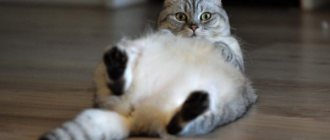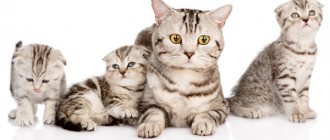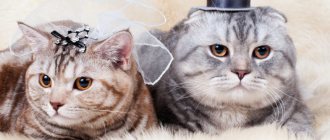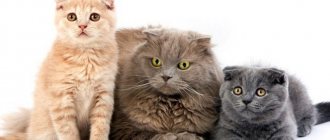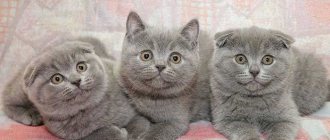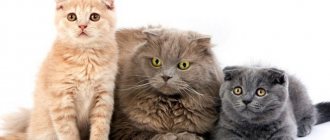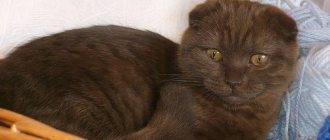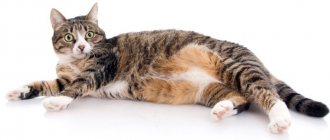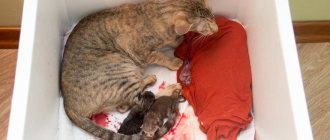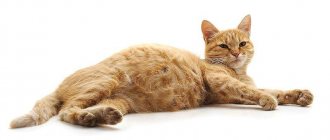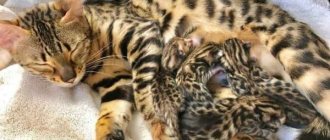Which cats may need obstetric care?
As already noted, cats require obstetric care extremely rarely. The process of giving birth to kittens most often occurs naturally and without any problems.
- Weakness of labor can most often be observed in older cats (over 7-9 years old) and in a British cat that is overweight.
- Disturbances in the course of labor often accompany those who have been ill during pregnancy, as well as those in a state of recovery after any serious illness.
- Monitoring childbirth is strictly indicated if the woman in labor has a history of any cardiac and/or pulmonary pathologies before pregnancy, as well as viral infections during pregnancy. In the future, it is better not to breed such cats anymore.
- In a Scottish cat, childbirth is often hectic, regardless of whether it is the first or not, so the presence of the owner at the most important moment is very desirable. In this breed, special attention should be paid to the selection of a cat due to the large variation in animal sizes. If a small Scottish cat is paired with an overly large cat, then obstetric care is guaranteed, and maybe even a caesarean section.
- Artificially bred cat breeds often lack maternal instinct, so owners often have to take responsibility not only for giving birth, but also for raising kittens. Sometimes this also occurs in fold-eared cats.
At what age can you knit tartan?
The first heat in Scottish cats, like in other cats, should be expected at 8 months. However, the body has not yet finished growing, and early pregnancy can undermine the health of the pet. And the offspring of a precocious mother will not be in good health.
Scots are considered large pets, so they are ready for the first mating later than cats of smaller breeds. The optimal age for the first pregnancy is one and a half years.
A partner for the Scottish female should be looked for several months before the intended mating, preferably not far from home, in order to have time to connect the couple on the 2nd or 3rd day of estrus.
Knitting features
The Scottish Fold cat reaches sexual maturity at 8 months. The pet becomes extremely active, screams loudly and demands the cat. Breeders do not recommend mating at an early age. The body of a Scottish Fold cat is not yet ready for childbirth, even after puberty. Mating is best done after one year and at least after 4-5 heats.
It is worth paying attention to a potential partner. A Scottish Fold cat should only be mated with a straight-eared male. This is an unshakable rule that cannot be broken. Otherwise, when two fold-eared cats are mated, the offspring are born incompetent and soon die.
This is due to the lop ear gene, which greatly affects the musculoskeletal system. Simply put, this is a hereditary disease that manifests itself in the first offspring.
ATTENTION! Before the first mating, it is mandatory to conduct an examination at a veterinarian or in a clinic. The specialist will conduct an examination and, if necessary, prescribe treatment, especially if the cat is purebred. Before pregnancy, a Scottish cat must be completely healthy so that there are no complications during the birth process.
Mating a Scottish cat is a responsible occupation. Particular attention should be paid to the health of the future partner and his pedigree.
Signs of pregnancy in Scottish cats
After mating, the cat calms down and becomes imposing. If the pet does not have contact with other animals at this time and eats according to its needs, the onset of pregnancy proceeds without problems. The first signs of pregnancy are observed 2-3 weeks after conception. The cat, as well as the woman, experiences attacks of morning sickness, characteristic of toxicosis of pregnancy.
The pet's nipples begin to turn pink, and the hair around them gradually falls out. However, such changes are individual and ultrasound is a reliable test for pregnancy. The first examination is usually carried out 3 weeks after mating.
Be sure to read:
Can a cat give birth to one kitten if the fetus is in the birth canal, what to do?
Even an inexperienced owner can determine that a cat is pregnant in the sixth week of gestation. By this time, her belly is rounded, her nipples swell, and her mammary glands enlarge.
How to avoid complications when giving birth to kittens
To minimize the risks of developing pregnancy pathologies and reduce to zero the risks of disruption of the course of labor, it is enough to:
- do not mate with each other animals that do not have pedigrees;
- provide ideal conditions for keeping and feeding a pregnant cat;
- promptly vaccinate the future mother cat and treat it against worms and ectoparasites;
- limit contact of a heavily pregnant cat with children and strangers;
- Never use any medications at all without a doctor’s prescription.
You should understand and remember that genetics is an unpredictable thing in most cases, and even if all the conditions for keeping a pregnant cat are met, unhealthy kittens may be born to her or the birth will occur with complications. It’s impossible to foresee everything, so make it a rule to choose a permanent veterinarian whom you can contact in emergencies!
Behavior of a pregnant fold cat
A pregnant cat changes its behavior. Hormonal surges change behavior. The cat alternately pets and looks irritated. Fetal development increases food requirements during the fourth week of pregnancy. At that time, the feed portion can be increased by 10-15%. In subsequent weeks, the animal is no longer restricted in food, but in order to avoid overeating, it is fed in small portions, but often.
The best option is to switch to ad libitum feeding with dry granules. The fifth week of pregnancy has only just begun, and the Scotswoman is already beginning to nest: she is looking for a secluded place. If the owners are planning to purchase a cat house, then this time is most suitable for the implementation of the intention.
During the seventh week, the cat may lose its appetite for a while. The embryos begin to grow fur and the cat hibernates at this time. The body is rebuilt, some of the nutrients are redirected into the formation of fruits to prepare the mammary glands for lactation. This process requires calmness, so the cat becomes drowsy.
In the last weeks before lambing, the Scotch cow becomes active again, once again walking around the property in search of a more convenient nest. It's time to satisfy your curiosity and repeat the ultrasound. You can determine the number of fruits and observe their movements. However, someone may be undetected and the actual number of kittens turns out to be greater than expected.
Nutrition
In the first weeks of pregnancy, the Scottish cat eats as usual. But in the later stages, the pet gradually refuses frequent meals because... kittens grow and take up all the space in the stomach. In this case, you should reduce the diet, but give portions more often 4-5 times a day.
For a pregnant cat, not just a proper diet is important, but also one rich in minerals and vitamins. It would be a good idea to add special vitamin complexes to the bowl, which can be purchased at the pharmacy.
If your cat's diet consists of dry food, it is recommended to gradually add canned food for kittens to the bowl. By the end of pregnancy, the menu should preferably consist of canned food. When eating natural foods, experts recommend including the following foods in your diet:
- boiled meat (about half of the diet);
- boiled vegetables;
- eggs;
- small portions of lean boiled fish (in no case sea fish!)
To improve the functioning of the digestive system, it is recommended to add beet puree to the diet.
To actively produce milk, you can feed your cat a salad of scalded nettle leaves. To facilitate childbirth and prevention, you can give a decoction of raspberry leaves. Twice a day - morning and evening.
What to feed a pregnant Scottish Fold cat
No special food has been developed for pregnant and lactating cats. Manufacturers of ready-made food believe that the nutritional needs of a mother cat are the same as those of kittens. Therefore, it is recommended to switch a pregnant pet to baby food from the moment pregnancy is considered established.
Be sure to read:
Pregnant Sphynx cat: how to find out about the position, changes in behavior and appearance, how long they walk
That is, if on the 25th day after mating an ultrasound showed the presence of embryos, the pet begins to gradually replace the previous food with a new one. This should be done gradually over a week to prevent feeding stress, which will negatively affect the fruit.
If an ultrasound was not performed for some reason, the transition to a new food begins when pregnancy is established based on other signs.
Malyshovsky food is as close as possible to milk in terms of energy and protein concentration, therefore it contains a lot of fat. For this reason, it should not be given immediately after mating, since Scottish females are prone to obesity.
The best option is universal holistic food such as Acana or Orijen, or specialized food Royal Canin Mother & Babycat. Adherents of natural food should create a diet that is not inferior in nutritional value to the indicated ready-made food.
Reproduction
Anyone who decides to seriously engage in breeding Scottish Fold cats should imagine that this is not only an interesting activity that gives a lot of joy and pleasure, but also a great responsibility. In addition, this hobby will require a lot of effort, time and money from the breeder.
It is necessary to clearly formulate for yourself the goal for which it is worth starting such a complex undertaking. The breeder must be prepared for the fact that many difficulties may arise along the way. He may face the death of the cat during childbirth or in the postpartum period. He may be faced with the task of artificial feeding and caring for kittens. He may become confused if labor weakens or if the cat gives birth in a pathological manner.
Everything should be taken into account, for example, whether the cat’s owner is ready to make a decision on euthanasia if kittens are born with developmental defects, such as a cleft lip or cleft palate. The breeder must be able to cope with any difficulties, be it the treatment of animals or large material costs.
When purchasing a Scottish Fold cat, the breeder hopes that he will be able to recoup his costs by selling kittens. But this may not always happen, so first of all it is necessary to anticipate and take into account all the costs of keeping and caring for the animal. These may include the cost of immunization against diseases, covering the cat, paying for veterinarian services, purchasing supplies (dishes and other accessories), and the cost of raising kittens to the age when they can be sold. It is also necessary to take into account the demand for Scottish Fold cats for the current period and the availability of potential customers.
How to help a Scottish woman during childbirth
The first aid before lambing is preparing the den. The simplest option is a cardboard box with holes cut for ventilation, lined with paper and covered with a soft cloth. The future house for kittens is placed in a secluded place. The nesting cat is picked up and placed in a prepared place. If the cat shows willfulness and lambs in another place. She, along with her offspring, is placed in a prepared den, from which she will never leave.
It is good if a veterinarian is present during the birth, but most owners can provide assistance on their own. Most often, the cat copes on its own.
Be sure to read:
A pregnant cat has bleeding: normal or pathological, what to do when you need help
Labor begins with the release of amniotic fluid. The kitten is born in the amniotic sac, which bursts and the cat gnaws the umbilical cord. If she did not do this, you need to cut the cord with sterile scissors and treat the stump with tincture of iodine. The mother usually eats the placenta. This is normal, but you should not allow more than two placentas to be eaten. When the cat has the intention of eating another afterbirth, food is added to it.
If the bubble does not open on its own, it is broken with your fingers. The kitten is shaken, the liquid is removed from the mouth with a baby syringe and placed on the mother.
The normal interval between the births of kittens is considered to be a quarter of an hour. All afterbirths come out within half a day after the birth of the last kitten. If labor is difficult, call a veterinarian.
What you need to have on hand to help
A non-specialist is unlikely to be able to accurately determine whether in a given specific situation the help of a specialist is needed or whether independent participation will be sufficient. But if it is definitely decided to control the birth without a veterinarian, then the list of available materials should be as follows:
- surgical gloves (disposable or sterile) – 2-3 pairs;
- moisture-absorbing medical diapers (unscented) – 4-6 pieces, depending on size;
- a small waffle towel (clean, intensively ironed) - may be needed for resuscitation of a weak newborn baby;
- gauze or bandage wipes (sterile) – up to 2 packs;
- good cutting blunt scissors;
- surgical silk, catgut or any other surgical thread for tying the umbilical cord - sterile initially or soaked in alcohol on the eve of the expected birth;
- a small rubber bulb (syringe) – for pumping out mucus from the kitten’s airways;
- sterile petroleum jelly;
- hydrogen peroxide 3%, betadine or brilliant green solution;
- ammonia;
- a heating pad or electric sheet if the room is cool.
We recommend reading: Average life expectancy of different types of animals
Only after consultation with a veterinarian (!) the following are added to the list:
- oxytocin;
- lauritin;
- calcium gluconate;
- disposable syringes - insulin and regular, 2 ml volume.
In general, consultation with a veterinarian is required! If a decision has been made to perform obstetric care on your own, then there must be a clear understanding of what is needed, why, and when the use of this or that material/drug will be appropriate.
Newborns
During the first 21 days of life, normal cubs only feed on milk and doze. In most cases, the mother independently looks after the babies and their bed. After the first week, kittens begin to develop eyes. They begin to fully see the world around them by two weeks. All newborns have heavenly colored eyes.
It is replaced with a permanent one in the third month. Babies' ears open on the 5th-8th day after birth, and straighten after 2 weeks.
The fluffies try to get up from the age of 18 days, and after another four days they can walk. From now on, they can eat from a plate themselves. If possible, you should not disturb the kittens again before they learn to crawl, since the mother will worry if someone touches her babies.
It is believed that the Scottish baby, caressed by people, will not get along well with his mother and the entire litter in the future. But if there is no communication with a person at all, the animal may show fear and anger, and become a slob.
Postnatal care
Half a day or a day after birth, you need to call a doctor to examine the mother. He will look to see if there are any more cubs in the womb and test the quality of the milk.
In the first 7 days, the animal’s temperature should be measured, if it is not lower than 39.4 C, this fact means there are problems. Postpartum discharge of blood or grass-colored fluid that lasts up to 3 weeks is considered normal.
If there is pus in them and they last longer than indicated, you need to contact a veterinary clinic.
A nursing pet should be walked only under supervision, because if she comes into heat and mates, she will become pregnant again, and this can significantly undermine her health.
